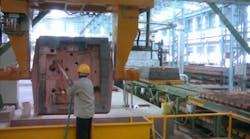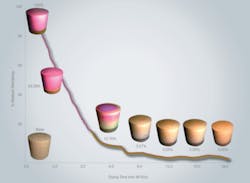Through intensive R&D, ASK Chemicals aims to provide metalcasting operators with a continuous supply of new and efficient problem-solving techniques. Its most recent development is a fireproof, water-based coating that incorporates a wet/dry color indicator. SOLITEC DI changes color during drying, providing an easily discernible, optical indication of its drying status.
Typically, metalcasters have opted to apply fireproof solvent coatings were. However, occupational health and safety and environmental protection standards, as well as economic considerations, encouraged some “rethink” among coating manufacturers.
The new approach was (and is) directed at developing environmentally friendly and sustainable solutions, in place of petrochemical byproducts like solvents. The water-based technology from ASK Chemicals is a successful example of the effective transfer of expertise from solvent- to water-based coating formulations.
ASK Chemicals has a longstanding reputation for developing new technologies and products to benefit foundry industry and promote the use of econ-friendly products and processes. With SOLITEC DI, the company has developed a technology by which the fireproof coating used undergoes a noticeable color change as soon as it dries.
Complete drying of the coating layer is absolutely essential to avoid casting defects such as blisters, gas and slag inclusions, porosity, or a rough surface finish. Although insufficient drying will lead to rejection and incurs reworking costs, excessive drying often entails higher energy costs. Both situations result in loss of productivity and reduced efficiency.
As yet, there is no simple analytical method for metalcasters to determine a coating’s degree of dryness. However, this problem is addressed by SOLITEC DI. The water-based coating changes color when drying, acting as a wet/dry indicator, and in that way a previously unavailable tool for foundries to promote productivity and product quality. The visual confirmation of the drying state makes SOLITEC DI an exceptional quality assurance instrument.
If sand molds or cores exhibit soft areas due to inadequate compaction, i.e. loose areas with low density, these will tend to absorb more moisture from the coating than the surrounding areas, which means they take longer to dry. Here, the clearly discernible color change supports higher productivity, and optimizes quality for cores and molds. Problem cores and molds are recognized easily and spoiled castings can be avoided before even greater investment outlay is incurred.
SOLITEC DI is being used successfully by metalcasters, with particularly strong acceptance by steel and ductile iron foundries. This acceptance demonstrates the cost benefits of processes, too.
The fireproof water coating with wet/dry color indicator is an innovative approach that combines the original intended purpose, environmental considerations and a high degree of functionality in an otherwise familiar product.










